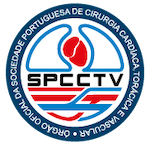SAFETY AND FEASIBILITY OF CONSERVATIVE AORTIC VALVE SURGERY: SINGLE CENTER EXPERIENCE
DOI:
https://doi.org/10.48729/pjctvs.121Abstract
Background: In selected cases, aortic valve repair (RVAo) is an alternative to prostesic aortic valve replacement.
Aim: To compare mid-term survival, need of reoperation and echocardiographic findings associated with RVAo.
Methods: Retrospective single-center cohort study including consecutive patients younger than 70 years-old, with non-stenotic aortic valve disease, who underwent RVAo between 2012 and 2017. A comparison was made with a group of patients who underwent mechanical aortic valve replacement (SVAo) in the same period. The groups were characterized and compared using Chi-Square and t-tests for independent samples and survival and reoperation were analyzed using Kaplan-Meier curves and Cox regressions.
Results: We included 72 patients submitted to RVAo. Mean follow-up time was 4 years, maximum 7. Although the mean age was relatively low (47±13 years), patients undergoing RVAo presented a lower prevalence of rheumatic etiology (3%). The cardiopulmonary bypass (148±74 minutes) and cross clamping aortic times (108±52 minutes) are the usual times for this type of surgery and similar to those of the comparing group (SVAo). In the echocardiographic follow-up (median of 3 months), we verified a left ventricular mass regression of 21% and a prevalence of aortic insufficiency of 4%. At 7 years, cumulative survival and freedom from reoperation of patients undergoing RVAo were 98.8% and 97.6%, respectively.
Conclusion: RVAo can be a safe and effective alternative, with good mid-term results if patient selection is judicious.
Downloads
References
Baumgartner H, Falk V, Bax JJ, De Bonis M, Hamm C, Holm PJ, Iung B, Lancellotti P, Lansac E, Muñoz DR, Rosenhek R, Windecker S, Zamorano JL. 2017 ESC/EACTS Guidelines for the management of valvular heart disease. European Heart Journal. doi:10.1016/j.rec.2017.12.013.
Boodhwani M, El Khoury G. Aortic valve repair: indications and outcomes. Current cardiology reports. doi: 10.1007/s11886-014-0490-7
Augoustides JG, Szeto WY, Bavaria JE. Advances in aortic valve repair: focus on functional approach, clinical outcomes, and central role of echocardiography. Journal of cardiothoracic and vascular anesthesia. doi: 10.1053/j.jvca.2010.08.007
Bajona P, Suri RM, Greason KL, Schaff HV. Outcomes of surgical aortic valve replacement: the benchmark for percutaneous therapies. Progress in cardiovascular diseases. 2014 May 1;56(6):619-24. doi: 10.1016/j.pcad.2014.02.004
Boodhwani M, de Kerchove L, Glineur D, Poncelet A, Rubay J, Astarci P, Verhelst R, Noirhomme P, El Khoury G. Repair-oriented classification of aortic insufficiency: impact on surgical techniques and clinical outcomes. The Journal of thoracic and cardiovascular surgery. doi: 10.1016/j.jtcvs.2008.08.054.
Minakata K, Schaff HV, Zehr KJ, Dearani JA, Daly RC, Orszulak TA, Puga FJ, Danielson GK. Is repair of aortic valve regurgitation a safe alternative to valve replacement? The Journal of Thoracic and Cardiovascular Surgery. doi: 10.1016/j.jtcvs.2003.09.018
le Polain de Waroux JB, Pouleur AC, Robert A, Pasquet A, Gerber BL, Noirhomme P, El Khoury G, Vanoverschelde JL. Mechanisms of recurrent aortic regurgitation after aortic valve repair: predictive value of intraoperative transesophageal echocardiography. JACC: Cardiovascular Imaging. doi: 10.1016/j.jcmg.2009.04.013
Carr JA, Savage EB. Aortic valve repair for aortic insufficiency in adults: a contemporary review and comparison with replacement techniques. European journal of cardio-thoracic surgery. doi:10.1016/j.ejcts.2003.09.018
Prodromo J, D'Ancona G, Amaducci A, Pilato M. Aortic valve repair for aortic insufficiency: A review. Journal of cardiothoracic and vascular anesthesia. doi: 10.1053/j.jvca.2011.07.014
David TE. Current Readings: Aortic Valve–Sparing Operations. In Seminars in thoracic and cardiovascular surgery 2014 Sep 1 (Vol. 26, No. 3, pp. 231-238). WB Saunders. doi: https://doi.org/10.1053/j.semtcvs.2014.10.002
Lancellotti P, Tribouilloy C, Hagendorff A, Moura L, Popescu BA, Agricola E, Monin JL, Pierard LA, Badano L, Zamorano JL, European Association of Echocardiography. European Association of Echocardiography recommendations for the assessment of valvular regurgitation. Part 1: aortic and pulmonary regurgitation (native valve disease). European Journal of Echocardiography. doi: 10.1093/ejechocard/jeq030
David TE. Aortic valve repair and aortic valve-sparing operations. The Journal of thoracic and cardiovascular surgery. doi: 10.1016/j.jtcvs.2014.11.019
Komiya T. Aortic valve repair update. General thoracic and cardiovascular surgery. doi: 10.1007/s11748-015-0523-1
Aicher D, Holz A, Feldner S, Köllner V, Schäfers HJ. Quality of life after aortic valve surgery: replacement versus reconstruction. The Journal of thoracic and cardiovascular surgery. doi: 10.1016/j.jtcvs.2011.02.006
Kearney K, Croce B, Harris R. Aortic valve repair. Annals of cardiothoracic surgery. doi: 10.3978/j.issn.2225-319X.2013.01.01
Subramanian S, Borger MA. Aortic valve reconstruction: current status. Herz. doi: 10.1007/s00059-010-3325-3
Aicher D, Schäfers HJ. Aortic valve repair—current status, indications, and outcomes. In Seminars in thoracic and cardiovascular surgery 2012 Sep 1 (Vol. 24, No. 3, pp. 195-201). WB Saunders. doi: 10.1053/j.semtcvs.2012.08.003
Antunes MJ. Aortic valve repair: still a dream?. European Journal of Cardio-Thoracic Surgery. doi: https://doi.org/10.1016/S1010-7940(96)01104-9
Haydock MD, Haydock DA. Aortic valve repair: 49 year follow-up. Heart, Lung and Circulation. doi: 10.1016/j.hlc.2012.12.001






